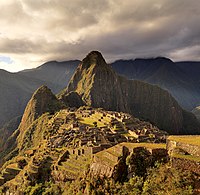Our website is made possible by displaying online advertisements to our visitors.
Please consider supporting us by disabling your ad blocker.
Hill town

A hill town is a type of a settlement[1] built upon hills. Often protected by defensive walls, steep embankments, or cliffs, such hilltop settlements provided natural defenses for their inhabitants. The term "hill town" is occasionally a bit of misnomer, as some of these settlements are built on "pedestals" other than hills in the strict geographical sense.[2]
In Europe, especially in Italy, Spain, Portugal and southern France, such towns were common.[3] In Italy in particular, hill towns comprised about half of the important towns in the Middle Ages.[4] In many cases the Roman and medieval sites are now abandoned due to their remote locations,[2] for example in the south of England. In parts of Italy (Tuscany and Umbria), however, most of the ancient hill towns are still populated, some becoming cities, like Siena.[4]

The Spanish even brought the traditional European hill town to the Americas, a notable example being the 16th century Mexican hill town of Guanajuato. However, fortified hill towns were by no means solely a European creation. For instance, Incan fortified hill towns predated the arrival of the Spanish by many centuries and rival those of Europe, including Machu Picchu, an Incan hill town completed in the mid-15th century in Peru, now in ruins.[citation needed] Construction of fortified hill towns was common in many civilizations. Ancient examples can also be found in Africa and Asia.
Despite the challenges of building settlements on uneven ground, cities in complex topographic settings are "routinely" considered to be among most distinctive ones,[6] pleasing to the eye when observed from within or enjoyed as a part of the landscape.[5]
- ^ Marshall 2005, p. 474.
- ^ a b Potter 1972, p. 135.
- ^ Owen 2003, p. 3.
- ^ a b Brooke 2016, Cities and towns.
- ^ a b Owen 2003, p. 4.
- ^ Kullmann 2020, p. 47.
Previous Page Next Page


